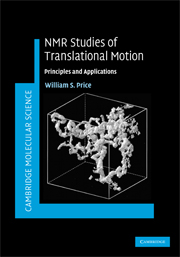Book contents
- Frontmatter
- Contents
- Preface
- Acknowledgements
- Abbreviations
- 1 Diffusion and its measurement
- 2 Theory of NMR diffusion and flow measurements
- 3 PGSE measurements in simple porous systems
- 4 PGSE measurements in complex and exchanging systems
- 5 PGSE hardware
- 6 Setup and analysis of PGSE experiments
- 7 PGSE hardware and sample problems
- 8 Specialised PGSE and related techniques
- 9 NMR imaging studies of translational motion
- 10 B1 gradient methods
- 11 Applications
- Appendix
- Index
- References
10 - B1 gradient methods
Published online by Cambridge University Press: 06 August 2010
- Frontmatter
- Contents
- Preface
- Acknowledgements
- Abbreviations
- 1 Diffusion and its measurement
- 2 Theory of NMR diffusion and flow measurements
- 3 PGSE measurements in simple porous systems
- 4 PGSE measurements in complex and exchanging systems
- 5 PGSE hardware
- 6 Setup and analysis of PGSE experiments
- 7 PGSE hardware and sample problems
- 8 Specialised PGSE and related techniques
- 9 NMR imaging studies of translational motion
- 10 B1 gradient methods
- 11 Applications
- Appendix
- Index
- References
Summary
Introduction
Although having some distinct limitations (e.g., relatively weak gradients and poor directionality), B1-based measurements have some particular advantages over B0 gradient-based methods. However, B1-based techniques have so far received only limited usage and consequently in this chapter we provide only a cursory coverage of these techniques and the interested reader is referred to the pertinent reviews on the subject.
B1 gradients
B1 gradients are more complex than B0 gradients. Apart from purely technical considerations, there are three main differences between B0 and B1 gradients: (i) A B0 field couples only into the spin system along the z-axis, thus the effective gradient tensor is always truncated into an effective vector (see Section 2.2.2). Radio frequency fields, however, couple into the spin system from any orientation within the transverse plane. As a result the B1 gradient generally retains its tensor form when it couples into the spin system. (ii) When the same rf coil is used for both excitation and detection, any phase variation is cancelled during the measurement. But when an experiment involves two rf fields at the same frequency this cancellation no longer occurs and phase variations need to be considered. This spatial dependence of the phase difference between the two rf fields presents an additional complication (or opportunity). (iii) The third difference is that B1 fields are non-secular and so do not commute with internal Hamiltonians. Thus, unlike a B0 gradient, a B1 gradient cannot be treated additively with respect to internal Hamiltonians.
Information
- Type
- Chapter
- Information
- NMR Studies of Translational MotionPrinciples and Applications, pp. 308 - 312Publisher: Cambridge University PressPrint publication year: 2009
